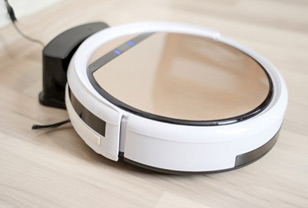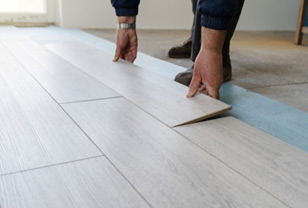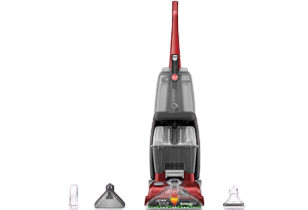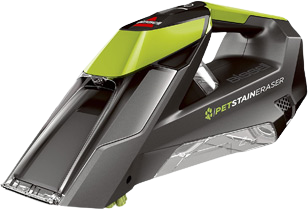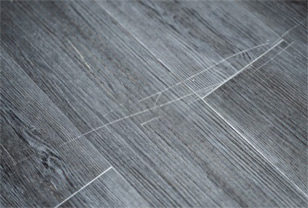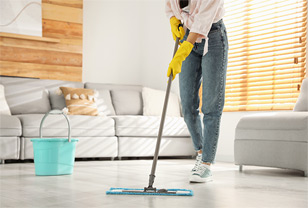How to Pressure Wash a House: Detailed Instructions to Bring Back Its Clean Look
- Tips on How to Remove a Popcorn Ceiling Faster and Easier
- The Easiest Way to Clean a Bathroom
- How to Fix a Vacuum - Improve Vacuum's Suction
But this does not mean that you have to let it stay there, free to accumulate year after year, dulling the beauty of your house. Pressure washing is a common method to get rid of the dirt and bring back the original look of your house's exterior.
Although it may sound easy, when you don't know precisely how to pressure wash your house, the damage it could cause is extensive. If you want to learn more about power washing your house, you have come to the right place.
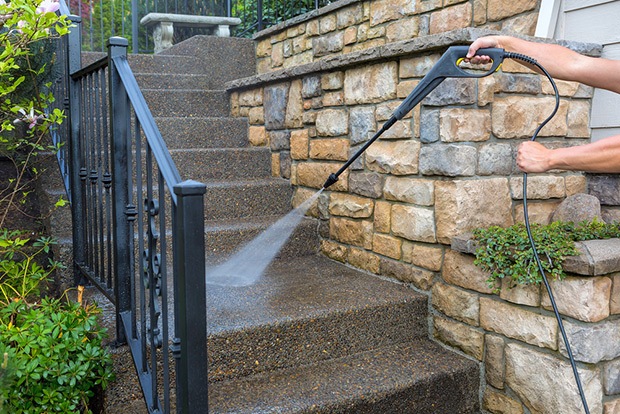
Benefits
≫ When you do it properly, pressure washing will clean grime, unsightly stains, and bird droppings from your house, improving its curb appeal and making you happy to see your home every day.
≫ If you do it right, it is a crucial part of house maintenance, keeping your home in perfect condition while preventing bigger troubles in the future.
≫ Pressure washing removes mildew and mold, which are harmful to the house itself and also your family's health. When mold and mildew go unnoticed, it will keep on growing within the walls, affecting and damaging your interior as well.
≫ You can also have a professional do the job for you – washing away a house's mildew is an important step when preparing the surfaces before repainting your house.
≫ Besides that, pressure washing is fantastic for railings and decks at low-pressure; vinyl, wood fences, and asphalt at medium; and stone or concrete driveways at high pressure.
Equipment
Best pressure washer works with a pump, which it uses to create the pressure of water running through the hose. It can be powered either by electricity or gasoline, both of which have their own pros and cons.
We decided to purchase a gas-powered pressure washer for our home because they can provide a higher GPM (gallons per minute) and PSI (pounds of pressure per square inch) than electric models. With that stronger power, you are able to clean your house much quicker.
But your needs and conditions may differ from ours, so please consider the following information before you make a final choice.
Electric Pressure Washers
Pros:
● Electric models do not emit harmful emissions into the environment, protecting your health.
● With an electric machine, you do not have to think about gas-related maintenance tasks like oil changes.
Cons:
● When using it indoors, you will need hearing protection equipment and a way to remove the used water.
Its power cannot match that of a gas-powered pressure washer. If the area you want to clean is large or very dirty, an electric model will take much longer to complete the task, and even after that, you may not get the desired result due to less power.
Electric pressure washers are not portable like their gasoline counterparts because you would need to provide a reliable way to connect them to a power outlet.
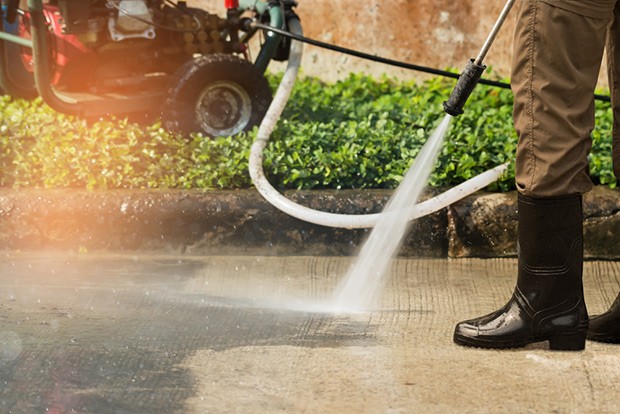
Nozzle
To apply detergent, you need a black-soaping nozzle, but to clean the house siding, you can use either the 40- or 25-degree nozzle tip.
For higher areas, extension wands are required because you need to avoid using ladders while pressure washing.
Detergent
You will need detergent because it can make your job much easier. If you are pressure washing without it, the siding could be at risk because the water pressure and amount required is higher to remove grime and dirt.
Whether your house siding is made of vinyl, wood, brick, or stucco, there are always specific detergents for cleaning it, but always remember to buy only environment-friendly products.
Brush Attachment
Though a brush attachment is not required when pressure-washing, you can use it to increase the cleaning performance and capacity of the washer.
With it, you can scrub and push the grime and dirt away using its bristles. Many models that are suitable for cleaning cars, boats, garbage bins are available for under $40.
Extension Wand
If you have a two-story house, you can make use of an extension wand to make your cleaning task easier. You can find additional attachments, which can be put at the end of the extension wand, to clean out the house gutters so you can stay on the ground safely.
Step-by-step Tutorial
Preparation
The most crucial part before pressure washing your house is protecting it from the water blast.
Close the doors and windows, and proceed carefully when cleaning around them if they are leaky. Protect the lawn, gardens, and shrubbery by covering them with plastic sheeting and drop cloths, and then secure them with duct tape. Move the patio furniture or other items that water and flying debris could harm out of the way.
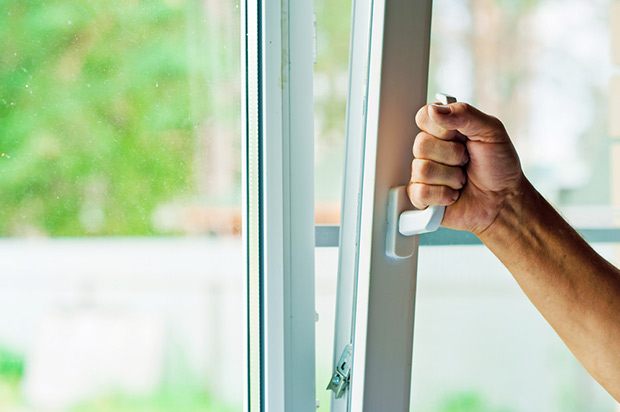
Before spraying the pressurized water stream onto your entire hose, make sure to check whether there are loose pieces of molding, window trim, siding on the house exterior, or gaps where water can leak into your house. Turn off the electric power to hardware and outlets.
You can also ask for help from someone in your family to make sure that the hose does not get tangled or stuck in the process, ensuring that things will proceed smoothly.
Ensure that you have soaked all the plantings and flowerbeds around your house with a garden hose before pressure washing. When the soil is saturated with water, it will help dilute the soap, making sure that the plants will not absorb any of the cleaning solutions.
Step 1: Rinse the exterior
Many people skip this step and proceed right to washing the siding by a sudsy stream.
While you could definitely do that, rinsing the area before spraying it with soap can remove dirt, dust, any loose debris, improving the effectiveness of soap later by enabling it to clean difficult areas.
By rinsing first, you can practice beforehand by adjusting the water sprayer pressure so you can determine the optimum spraying distance to clean the siding in a safe way and without risking damaging it.
While pressure washing siding, a good rule to remember is that you should start some feet away from your siding first, then move closer if necessary.
But this does not mean that you must rinse your entire house before going back and pressure washing it again. Rinse and wash the sections that you can so later, you will not have to lug the washer around and around your house.
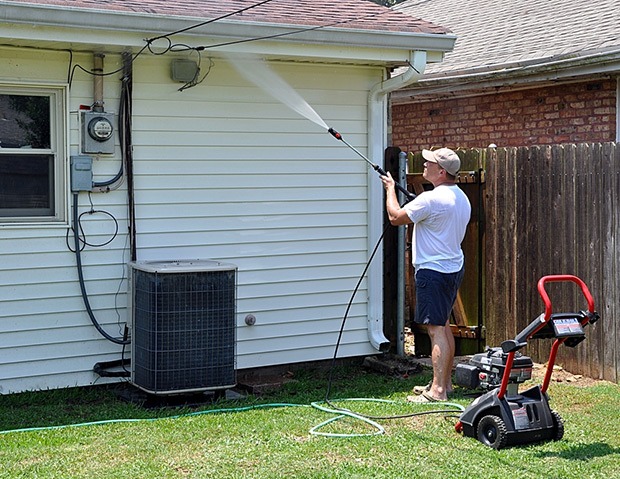
Step 2: Add the detergent
There are many pressure washing soaps available on the market, which you can find easily at your local store. Make sure to purchase the environment-friendly products, especially when you have pets or lots of plants outside your house.
Many people decide not to add any soap and go for a solution of 70% water / 30% white vinegar.
Ensure that you have a soap tip attached on the washer to provide a lower water stream pressure, and adjust the stream angle to 60 degrees, allowing you to apply the soap and increase the washing area more quickly.
➜ RELATED: The Ultimate Guide to Cleaning with Vinegar: Green Cleaners 101
Step 3: Setting up the scaffold
Set up the washer carefully before scrubbing so it can be ready to go.
On the back of your pressure washer, find the hose mount, and attach the garden hose to it and the faucet outside your house.
If you want to wash hard surfaces with high PSI, opt for 15-degree nozzles. But if the surfaces are softer, you can use lower PSI values with 30- or 25-degree nozzles. If you have a two-story house, clean the upper floor first, which means you will also need an extension wand.
Carefully set up the scaffolding beforehand by following the manufacturer's instructions. Place it at a far enough distance from the wall so you are able to stand in the middle of the scaffolding with a reach of 2 or 3 feet while holding the extension wand comfortable in your hand.
Lock the scaffold's wheels before using it.
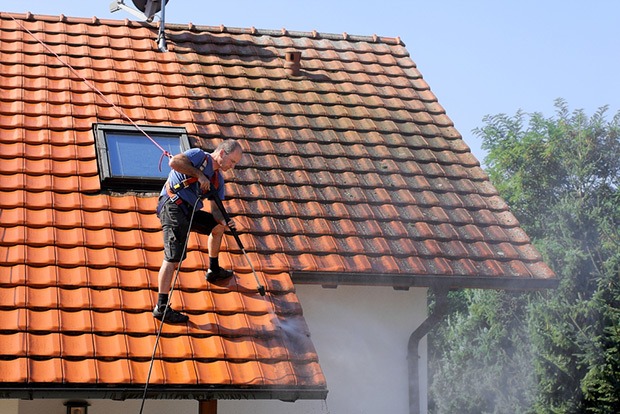
Step 4
Spray a 6- to 10-foot area of a floor thoroughly with the solution. Start at the bottom of the area and work your way up, firmly but gently scouring the house siding with a soft siding brush.
The reason you should wash from the bottom up is if you begin at the top, liquid and suds will run down on the wall, obscuring the areas that you might overlook.
If your house is a two-story structure, start washing the upper floor first, but remember to clean from the scaffolding's position to the top of your house.
Step 5
After thoroughly scrubbing the first area, put on your safety goggles. Stand firmly at a distance of 3 feet from the nozzle to the wall, then turn on your pressure washer.
If you find that this distance can help you clean the dirt, maintain it, but if you see any damage caused by the stream, decrease the power and move further away, in 4- or 6-inch increments, to figure out the distance that works best.
Step 6
When you have determined the most suitable distance, start from the top of the scrubbed area and work your way down – remember to spray the overhands first.
Use both your arms to reach up in a safe stance so that the recoil does not knock you off, in order to position the stream down with a 45-degree angle. By doing this, you can prevent the water from leaking into the sidings.
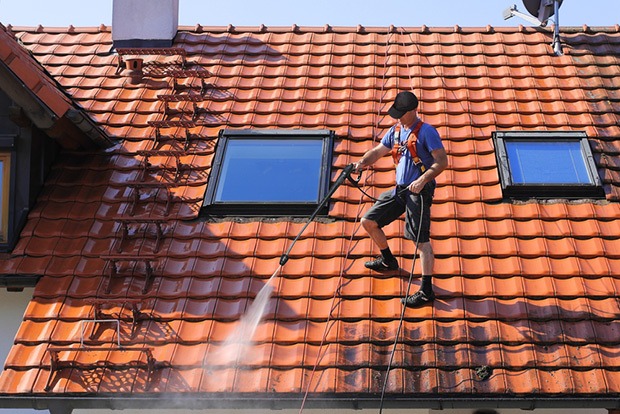
Step 7
Move to the next area, and repeat steps 4 to 6 until you have washed your entire house. When you’ve finished, remove the plastic sheeting and drop cloths, toss out the duct tape, and put away the equipment and cleaning agents.
Wait for the siding to dry completely before painting and decorating it.
➜ Picked For You: How to Get the Shine Back on a Laminate Floor
Tips and Warnings
Eye protection
Eye protection is a must. It's bizarre because while you never see a professional at a machine workshop working without eye protection, you always see a lot of DIY people messing around their houses without it.
At the very least, buy just a cheap pair of safety glasses to prevent eye injuries.
Water and electricity don't mix
Make sure to turn off all the outdoor power outlets, especially when they do no have waterproof covers over them.
Be careful when using ladders
Avoid them if possible because the pressure can push you off balance and lead to a fall. When you must use a ladder, ensure it is in a firm position with a proper angle of 75 to 80 degrees.
Closing Words
We hope this tutorial on how to power wash a house was helpful. In later articles, we will cover specific questions like how to pressure wash a house with vinyl siding or how to pressure wash a brick house, which may be concerns many of you have.
Remember to choose the right equipment, put the safety rules first, and practice the techniques carefully so that you won't damage your house’s exterior while using a pressure washer for house siding. With some water and effort, you can have a beautiful house like the early days.





